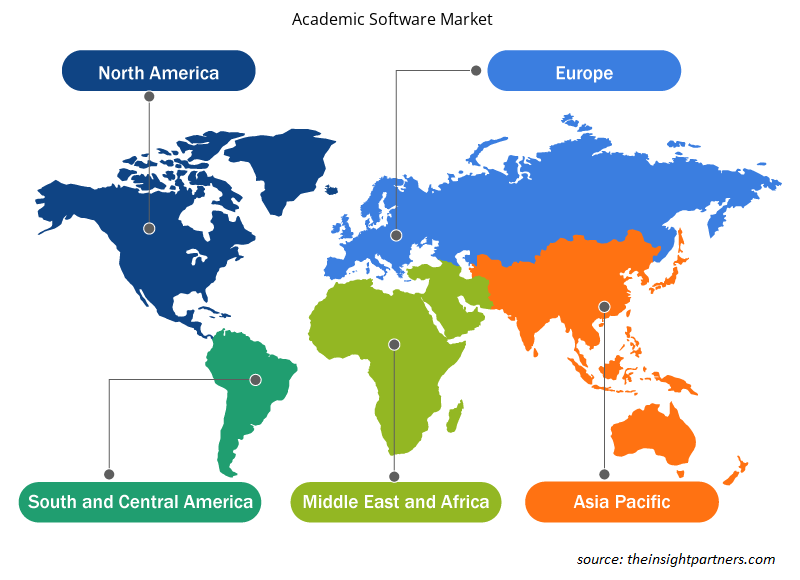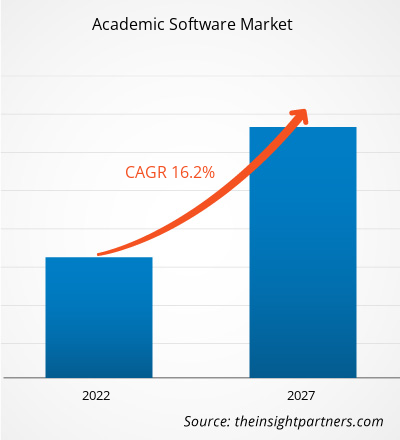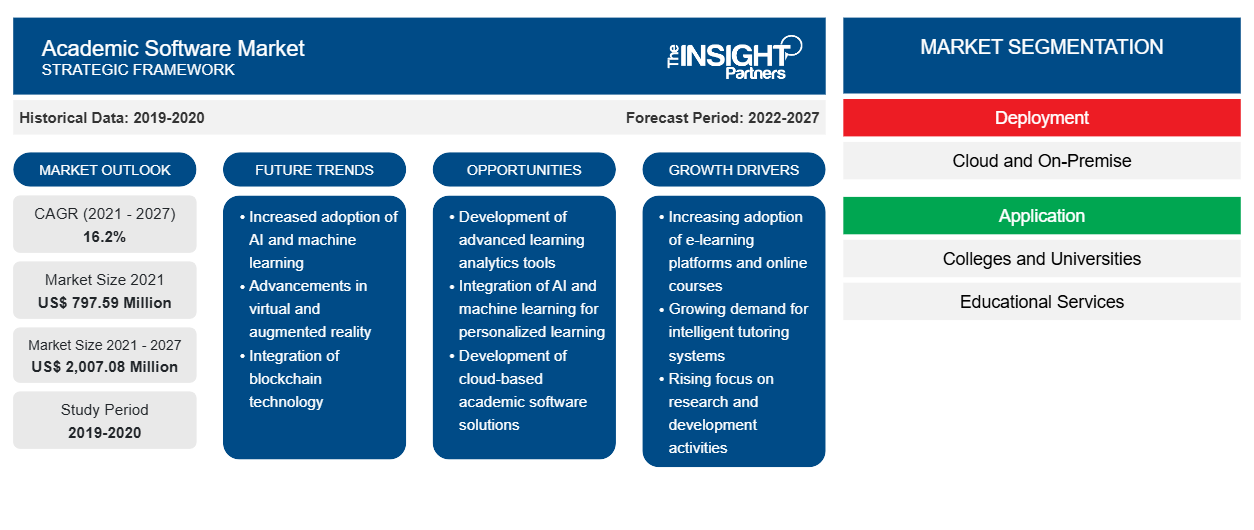من المتوقع أن ينمو سوق البرامج الأكاديمية من 797.59 مليون دولار أمريكي في عام 2021 إلى 2،007.08 مليون دولار أمريكي بحلول عام 2027. ومن المتوقع أن ينمو سوق البرامج الأكاديمية بمعدل نمو سنوي مركب قدره 16.2٪ خلال الفترة المتوقعة من 2021 إلى 2027.
إن زيادة اعتماد التعلم الإلكتروني عبر المؤسسات هو العامل الرئيسي الذي يدفع نمو سوق البرمجيات الأكاديمية. في التعلم الإلكتروني، من خلال قراءة أو مشاهدة المحتوى، فإنه يغير طريقة تقديم التعليم. العديد من دورات التعلم الإلكتروني مثل الرسوم المتحركة والبودكاست ومقاطع الفيديو تخلق بيئة تعليمية متعددة الوسائط وواقعية. يفتح التعلم الإلكتروني، المحتوى التعليمي، العديد من فرص التعلم الغامرة للمتعلمين من خلال أجهزة الكمبيوتر أو أجهزة الكمبيوتر المحمولة أو الأجهزة اللوحية أو الهواتف الذكية. بدلاً من التواجد في بيئة سلبية، يمكن للطلاب اختيار ما يحتاجون إلى تعلمه بسهولة وبسرعة. هذه الفوائد تزيد من الطلب على البرامج الأكاديمية في جميع أنحاء العالم.
لقد أثر وباء كوفيد-19 بشدة على قطاع التعليم في جميع أنحاء العالم. وقد أدى ذلك أيضًا إلى تعزيز اعتماد نظام التعليم عبر الإنترنت في جميع الاقتصادات الكبرى في جميع أنحاء العالم؛ وبالتالي، التأثير على اعتماد البرامج لتطبيقات مختلفة، مثل إلقاء المحاضرات وإدارة الطلاب والأنشطة التشغيلية الأخرى من مواقع بعيدة. وبالتالي، من المتوقع أن يؤثر التبني المتزايد للحلول المتقدمة تقنيًا في جميع أنحاء القطاع بشكل إيجابي على نمو سوق البرامج الأكاديمية أثناء الوباء.
بناءً على النشر، يتم تقسيم سوق البرامج الأكاديمية إلى سحابية ومحلية. في عام 2019، استحوذ قطاع السحابة على حصة أعلى في السوق. في السنوات الأخيرة، شهدت صناعة التكنولوجيا زيادة كبيرة في تبني الحوسبة السحابية. ويرجع ذلك إلى حقيقة أن الحوسبة السحابية تبسط وقت التنفيذ وتقلل تكاليف النشر بشكل كبير. وقد اجتذبت هذه الميزة عددًا كبيرًا من المستخدمين النهائيين؛ وبالتالي، تقدم غالبية شركات سوق البرامج الأكاديمية منتجات قائمة على السحابة بالتزامن مع الطلب المتزايد على البرامج القائمة على السحابة. بالإضافة إلى ذلك، تطورت البنية التحتية للإنترنت في البلدان المتقدمة وازدهرت في العديد من البلدان النامية، مما مكن المستخدمين النهائيين من الوصول إلى الحلول القائمة على السحابة في كل من البلدان المتقدمة والنامية.
قم بتخصيص هذا التقرير ليناسب متطلباتك
ستحصل على تخصيص لأي تقرير - مجانًا - بما في ذلك أجزاء من هذا التقرير، أو تحليل على مستوى الدولة، وحزمة بيانات Excel، بالإضافة إلى الاستفادة من العروض والخصومات الرائعة للشركات الناشئة والجامعات
-
احصل على أهم اتجاهات السوق الرئيسية لهذا التقرير.ستتضمن هذه العينة المجانية تحليلاً للبيانات، بدءًا من اتجاهات السوق وحتى التقديرات والتوقعات.
رؤى سوق البرمجيات الأكاديمية
دمج التقنيات مثل الذكاء الاصطناعي مع حلول البرمجيات الأكاديمية
الذكاء الاصطناعي هو تقنية تمنح أجهزة الكمبيوتر القدرة، بنفس الطريقة التي يتمتع بها البشر، على التواصل مع الناس وفهم الأحداث والتعلم والتفاعل معها. وعلى مر السنين، لم يكن للذكاء الاصطناعي تطبيقات ضخمة في مختلف الصناعات فحسب - مثل الأمن والمراقبة وتكنولوجيا المعلومات - بل شهد أيضًا ارتفاعًا في تبني التقنيات في قطاع التعليم. يتم اعتماد الذكاء الاصطناعي في المدارس والكليات والجامعات لأتمتة المهام المتكررة، مثل التصنيف والتحليل المالي وعمليات القبول. على سبيل المثال، يمكن معايرة الذكاء الاصطناعي لتعلم ونمذجة تصرفات المعلم أثناء التصنيف، من خلال برامج الكمبيوتر المتقدمة - مثل التصنيف الآلي - لتعيين الدرجات تلقائيًا في المستقبل. بمرور الوقت، يتعلم البرنامج المهارات الأكاديمية لطلاب متعددين، وبناءً على أدائهم، يعد خطط تدريب مخصصة.
رؤى السوق القائمة على النشر
بناءً على نوع النشر، يتم تقسيم سوق البرامج الأكاديمية العالمية إلى سحابية ومحلية. تشهد البرامج الأكاديمية المستندة إلى السحابة طلبًا مرتفعًا مقارنة بالبرامج الأكاديمية المحلية. يولد قطاع السحابة غالبية الطلب لأنه أقل تكلفة نسبيًا بسبب البنية التحتية القوية للشبكة في البلدان المتقدمة. بالإضافة إلى ذلك، يركز بائعو البرامج الأكاديمية المستندة إلى السحابة بشكل كبير على تطوير تصحيح أمان عالي المستوى من أجل القضاء على خطر الهجمات الإلكترونية. هذا العامل يخلق أيضًا طلبًا كبيرًا من المستخدمين النهائيين، وبالتالي يقود سوق البرامج الأكاديمية.
رؤى السوق القائمة على التطبيق
بناءً على التطبيق، يتم تقسيم سوق البرامج الأكاديمية إلى الكليات والجامعات والخدمات التعليمية وغيرها. إن زيادة اعتماد الحلول الحديثة في المؤسسات التعليمية والجامعات لتقديم دورات عبر الإنترنت وخارجها للطلاب إلى جانب المبادرة لتوفير حلول متقدمة لجميع الموظفين والطلاب تؤثر على اعتماد البرامج الأكاديمية. وهذا يغذي نمو السوق على مر السنين.
يركز اللاعبون العاملون في سوق البرمجيات الأكاديمية على الاستراتيجيات، مثل مبادرات السوق، والاستحواذات، وإطلاق المنتجات، للحفاظ على مواقعهم في سوق البرمجيات الأكاديمية. وفيما يلي بعض التطورات التي قام بها اللاعبون الرئيسيون في سوق البرمجيات الأكاديمية:
في ديسمبر 2020، قدمت منصة نظام معلومات الطلاب Alma ميزة متوسط النقاط التراكمية (GPA) التي تمت إضافتها إلى أداة دفتر الدرجات. يعتمد التصنيف القائم على المعايير (SBG) على مواءمة ملاحظات الطلاب وقياس التقدم مع المهارات المحددة التي يتم تدريسها وتقييمها، بدلاً من استخدام درجة واحدة لتغطية مواضيع أو معايير متعددة.
في يوليو 2020، قامت ConexED بتحديث تطبيق iOS الخاص بها إلى الإصدار 2.2.3 لتوفير تجربة أكثر سهولة في الاستخدام. يتيح هذا التطبيق للطلاب والموظفين وأعضاء هيئة التدريس الانضمام إلى الاجتماعات الافتراضية ومؤتمرات الفيديو على أجهزتهم المحمولة.
رؤى إقليمية حول سوق البرمجيات الأكاديمية
لقد قام المحللون في Insight Partners بشرح الاتجاهات والعوامل الإقليمية المؤثرة على سوق البرمجيات الأكاديمية طوال فترة التوقعات بشكل شامل. يناقش هذا القسم أيضًا قطاعات سوق البرمجيات الأكاديمية والجغرافيا في جميع أنحاء أمريكا الشمالية وأوروبا ومنطقة آسيا والمحيط الهادئ والشرق الأوسط وأفريقيا وأمريكا الجنوبية والوسطى.

- احصل على البيانات الإقليمية المحددة لسوق البرمجيات الأكاديمية
نطاق تقرير سوق البرمجيات الأكاديمية
| سمة التقرير | تفاصيل |
|---|---|
| حجم السوق في عام 2021 | 797.59 مليون دولار أمريكي |
| حجم السوق بحلول عام 2027 | 2,007.08 مليون دولار أمريكي |
| معدل النمو السنوي المركب العالمي (2021 - 2027) | 16.2% |
| البيانات التاريخية | 2019-2020 |
| فترة التنبؤ | 2022-2027 |
| القطاعات المغطاة |
حسب النشر
|
| المناطق والدول المغطاة |
أمريكا الشمالية
|
| قادة السوق وملفات تعريف الشركات الرئيسية |
|
كثافة اللاعبين في سوق البرمجيات الأكاديمية: فهم تأثيرها على ديناميكيات الأعمال
يشهد سوق البرمجيات الأكاديمية نموًا سريعًا، مدفوعًا بالطلب المتزايد من المستخدم النهائي بسبب عوامل مثل تفضيلات المستهلك المتطورة والتقدم التكنولوجي والوعي المتزايد بفوائد المنتج. ومع ارتفاع الطلب، تعمل الشركات على توسيع عروضها والابتكار لتلبية احتياجات المستهلكين والاستفادة من الاتجاهات الناشئة، مما يؤدي إلى زيادة نمو السوق.
تشير كثافة اللاعبين في السوق إلى توزيع الشركات أو المؤسسات العاملة في سوق أو صناعة معينة. وهي تشير إلى عدد المنافسين (اللاعبين في السوق) الموجودين في مساحة سوق معينة نسبة إلى حجمها أو قيمتها السوقية الإجمالية.
الشركات الرئيسية العاملة في سوق البرمجيات الأكاديمية هي:
- ألما
- برنامج CAMPUS CAFÉ
- كونيكس إي دي
- شركة إنفيسيو سوليوشنز
- قماش كامل
إخلاء المسؤولية : الشركات المذكورة أعلاه ليست مرتبة بأي ترتيب معين.

- احصل على نظرة عامة على أهم اللاعبين الرئيسيين في سوق البرمجيات الأكاديمية
سوق البرمجيات الأكاديمية – حسب النشر
- سحاب
- في الموقع
سوق البرمجيات الأكاديمية – حسب التطبيق
- الكليات والجامعات
- الخدمات التعليمية
- آحرون
سوق البرمجيات الأكاديمية – حسب المنطقة الجغرافية
-
أمريكا الشمالية
- نحن
- كندا
- المكسيك
-
أوروبا
- فرنسا
- ألمانيا
- روسيا
- المملكة المتحدة
- إيطاليا
- بقية أوروبا
-
آسيا والمحيط الهادئ (APAC)
- الصين
- الهند
- اليابان
- أستراليا
- كوريا الجنوبية
- بقية منطقة آسيا والمحيط الهادئ
-
الشرق الأوسط وأفريقيا
- المملكة العربية السعودية
- الامارات العربية المتحدة
- جنوب أفريقيا
- باقي منطقة الشرق الأوسط وأفريقيا
-
سام
- البرازيل
- الأرجنتين
- بقية سام
سوق البرمجيات الأكاديمية – نبذة عن الشركة
- ألما
- برنامج CAMPUS CAFÉ
- كونيكس إي دي
- شركة إنفيسيو سوليوشنز
- قماش كامل
- شركة باور فيستا للبرمجيات
- شركة كوالتريكس المحدودة
- شركة توبات مونوكل
- حوار حقيقي
- ويزهايف
- التحليل التاريخي (سنتان)، سنة الأساس، التوقعات (7 سنوات) مع معدل النمو السنوي المركب
- تحليل PEST و SWOT
- حجم السوق والقيمة / الحجم - عالمي، إقليمي، بلد
- الصناعة والمنافسة
- مجموعة بيانات إكسل
التقارير الحديثة
تقارير ذات صلة
شهادات العملاء
سبب الشراء
- اتخاذ قرارات مدروسة
- فهم ديناميكيات السوق
- تحليل المنافسة
- رؤى العملاء
- توقعات السوق
- تخفيف المخاطر
- التخطيط الاستراتيجي
- مبررات الاستثمار
- تحديد الأسواق الناشئة
- تحسين استراتيجيات التسويق
- تعزيز الكفاءة التشغيلية
- مواكبة التوجهات التنظيمية























 احصل على عينة مجانية ل - سوق البرمجيات الأكاديمية
احصل على عينة مجانية ل - سوق البرمجيات الأكاديمية